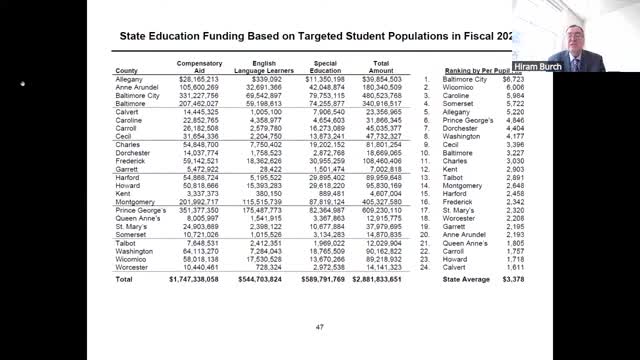Maryland allocates $3B for at-risk student programs amid funding challenges
February 07, 2025 | Eastern Shore, Delegation Committees, HOUSE OF REPRESENTATIVES, Committees, Legislative, Maryland
This article was created by AI summarizing key points discussed. AI makes mistakes, so for full details and context, please refer to the video of the full meeting. Please report any errors so we can fix them. Report an error »

During a recent meeting of the EAS Committee in Maryland, significant discussions centered around funding allocations for at-risk student groups, highlighting the pressing needs within local school systems, particularly on the Eastern Shore. Nearly $3 billion is earmarked for students eligible for free and reduced-price meals, with additional funding of approximately $500 million each for English language learners and special education services. This funding is crucial as it directly addresses the educational challenges faced by many students in these categories.
The meeting revealed that over half of public school students in Maryland qualify for free and reduced-price meals, indicating a widespread issue of poverty affecting educational access. For instance, in Somerset County, over 70% of students fall into this category, underscoring the urgent need for targeted support. The data presented also showed that counties like Wicomico and Talbot rank high in the percentage of English language learners, further emphasizing the diverse needs of the student population.
However, the meeting also addressed proposed reductions in state aid, with the governor suggesting a $262 million cut in funding. This reduction could shift financial burdens to local governments, which may have to cover increased costs for teachers' retirement and property assessments. For example, Caroline County could face an additional $509,000 in teachers' retirement costs alone. The proposed changes could significantly impact local budgets, particularly in smaller jurisdictions where resources are already stretched thin.
Despite these challenges, the committee noted that property assessments have been rising, which may provide some relief by increasing local revenue. The overall sentiment from the meeting was one of concern for the educational needs of vulnerable student populations, coupled with caution regarding the financial implications of state funding cuts.
As the committee prepares for future discussions, the focus remains on ensuring that local governments can adequately support their schools while navigating the complexities of state funding changes. The outcomes of these discussions will be pivotal in shaping the educational landscape for Maryland's students in the coming years.
The meeting revealed that over half of public school students in Maryland qualify for free and reduced-price meals, indicating a widespread issue of poverty affecting educational access. For instance, in Somerset County, over 70% of students fall into this category, underscoring the urgent need for targeted support. The data presented also showed that counties like Wicomico and Talbot rank high in the percentage of English language learners, further emphasizing the diverse needs of the student population.
However, the meeting also addressed proposed reductions in state aid, with the governor suggesting a $262 million cut in funding. This reduction could shift financial burdens to local governments, which may have to cover increased costs for teachers' retirement and property assessments. For example, Caroline County could face an additional $509,000 in teachers' retirement costs alone. The proposed changes could significantly impact local budgets, particularly in smaller jurisdictions where resources are already stretched thin.
Despite these challenges, the committee noted that property assessments have been rising, which may provide some relief by increasing local revenue. The overall sentiment from the meeting was one of concern for the educational needs of vulnerable student populations, coupled with caution regarding the financial implications of state funding cuts.
As the committee prepares for future discussions, the focus remains on ensuring that local governments can adequately support their schools while navigating the complexities of state funding changes. The outcomes of these discussions will be pivotal in shaping the educational landscape for Maryland's students in the coming years.
View full meeting
This article is based on a recent meeting—watch the full video and explore the complete transcript for deeper insights into the discussion.
View full meeting
